HONDA CLARITY FUEL CELL 2017 (in English) User Guide
Manufacturer: HONDA, Model Year: 2017, Model line: CLARITY FUEL CELL, Model: HONDA CLARITY FUEL CELL 2017Pages: 527, PDF Size: 17.62 MB
Page 11 of 527
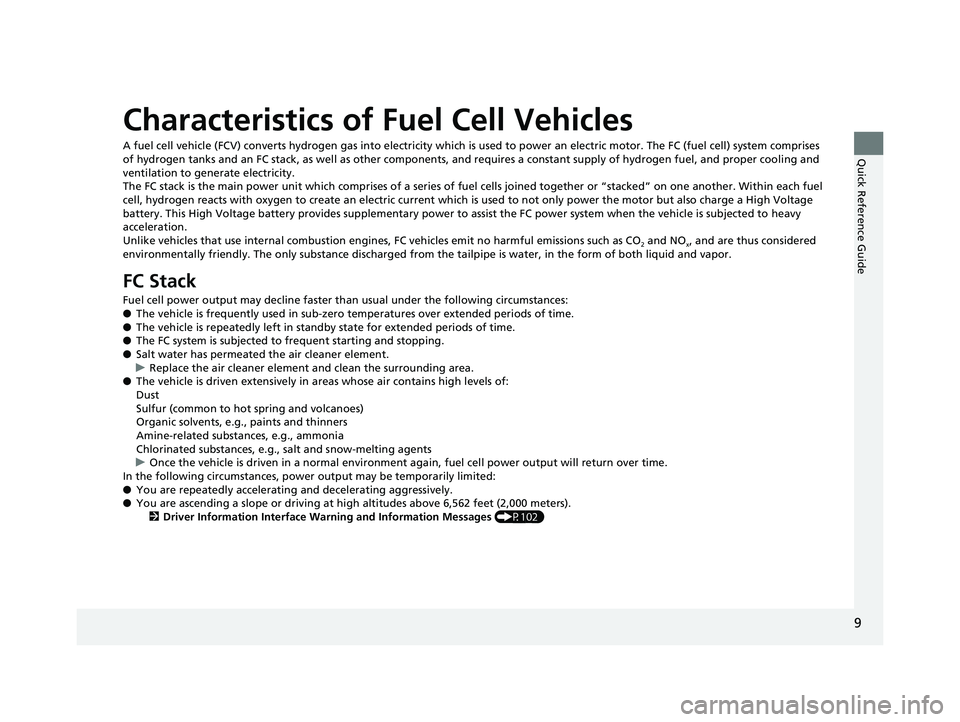
9
Quick Reference Guide
Characteristics of Fuel Cell Vehicles
A fuel cell vehicle (FCV) converts hydrogen gas into electricity which is used to power an electric motor. The FC (fuel cell) system comprises
of hydrogen tanks and an FC stack, as well as other components, and requires a constant supply of hydrogen fuel, and proper cooling and
ventilation to generate electricity.
The FC stack is the main power unit which comprises of a series of fuel cells joined together or “stacked” on one another. With in each fuel
cell, hydrogen reacts with oxygen to create an electric current whic h is used to not only power the motor but also charge a High Voltage
battery. This High Voltage battery provides supplementary power to assist the FC power system when the vehicle is subjected to heavy
acceleration.
Unlike vehicles that use internal combustion engines, FC vehicles emit no harmful emissions such as CO
2 and NOx, and are thus considered
environmentally friendly. The only substa nce discharged from the tailpipe is water, in the form of both liquid and vapor.
FC Stack
Fuel cell power output may decline faster th an usual under the following circumstances:
● The vehicle is frequently used in sub-zero temperatures over extended periods of time.
● The vehicle is repeatedly left in stand by state for extended periods of time.
● The FC system is subjected to frequent starting and stopping.
● Salt water has permeated the air cleaner element.
u Replace the air cleaner element and clean the surrounding area.
● The vehicle is driven extensively in areas whose air contains high levels of:
Dust
Sulfur (common to hot spring and volcanoes)
Organic solvents, e.g., paints and thinners
Amine-related substa nces, e.g., ammonia
Chlorinated substances, e.g., salt and snow-melting agents
u Once the vehicle is driven in a normal environment again, fuel cell power output will return over time.
In the following circumstances, power output may be temporarily limited:
● You are repeatedly accelerating and decelerating aggressively.
● You are ascending a slope or driving at high altitudes above 6,562 feet (2,000 meters).
2 Driver Information Interface Wa rning and Information Messages (P102)
17 CLARITY FCV PPO-31TRT6000.book 9 ページ 2016年10月27日 木曜日 午後3時11分
Page 12 of 527
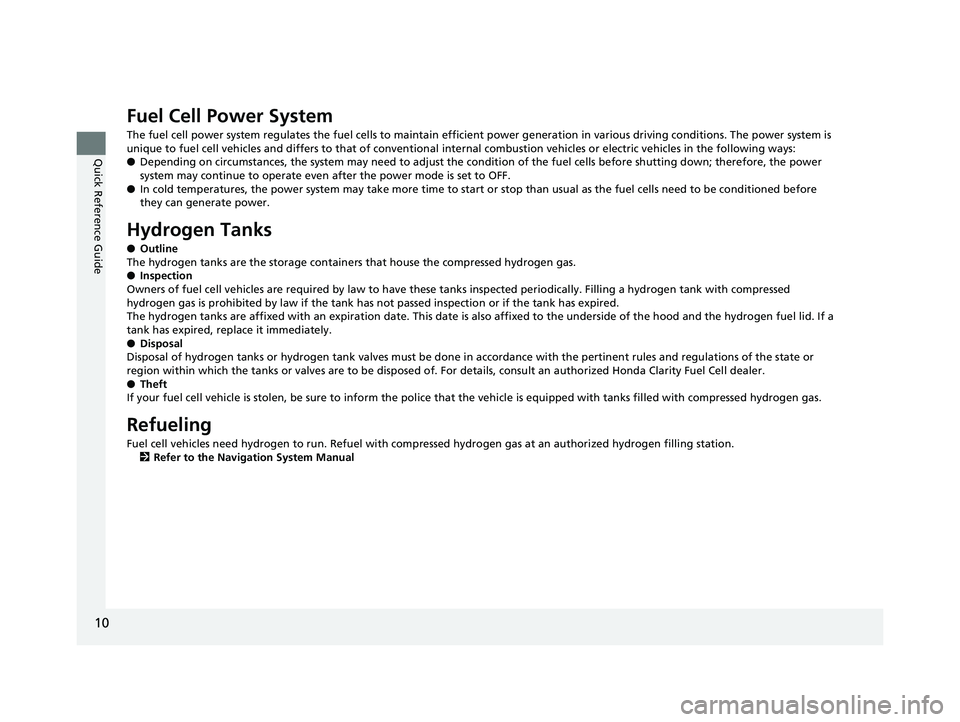
10
Quick Reference Guide
Fuel Cell Power System
The fuel cell power system regulates the fuel cells to maintain efficient power generation in various driving conditions. The power system is
unique to fuel cell vehicles and differs to that of conventional internal combustion vehicles or electric vehicles in the following ways:
● Depending on circumstances, the system may n eed to adjust the condition of the fuel cells before shutting down; therefore, the power
system may continue to operate even after the power mode is set to OFF.
● In cold temperatures, the power system may take more time to sta rt or stop than usual as the fuel cells need to be conditioned before
they can generate power.
Hydrogen Tanks
● Outline
The hydrogen tanks are the storage containe rs that house the compressed hydrogen gas.
● Inspection
Owners of fuel cell vehicles are required by law to have these tanks inspected periodically. Filling a hydrogen tank with compr essed
hydrogen gas is prohibited by law if the tank has not passed inspection or if the tank has expired.
The hydrogen tanks are affixed with an expiration date. This date is also affixed to the underside of the hood and the hydrogen fuel lid. If a
tank has expired, replace it immediately.
● Disposal
Disposal of hydrogen tanks or hydrogen tank valves must be done in accordance with the pertinen t rules and regulations of the state or
region within which the tanks or valves are to be disposed of. For details, consult an authorized Honda Clarity Fuel Cell deale r.
● Theft
If your fuel cell vehicle is stolen, be sure to inform the polic e that the vehicle is equipped with tanks filled with compresse d hydrogen gas.
Refueling
Fuel cell vehicles need hydrogen to run. Refuel with compressed hydrogen gas at an authorized hydrogen filling station.
2 Refer to the Navigation System Manual
17 CLARITY FCV PPO-31TRT6000.book 10 ページ 2016年10月27日 木曜日 午後3時 11分
Page 13 of 527
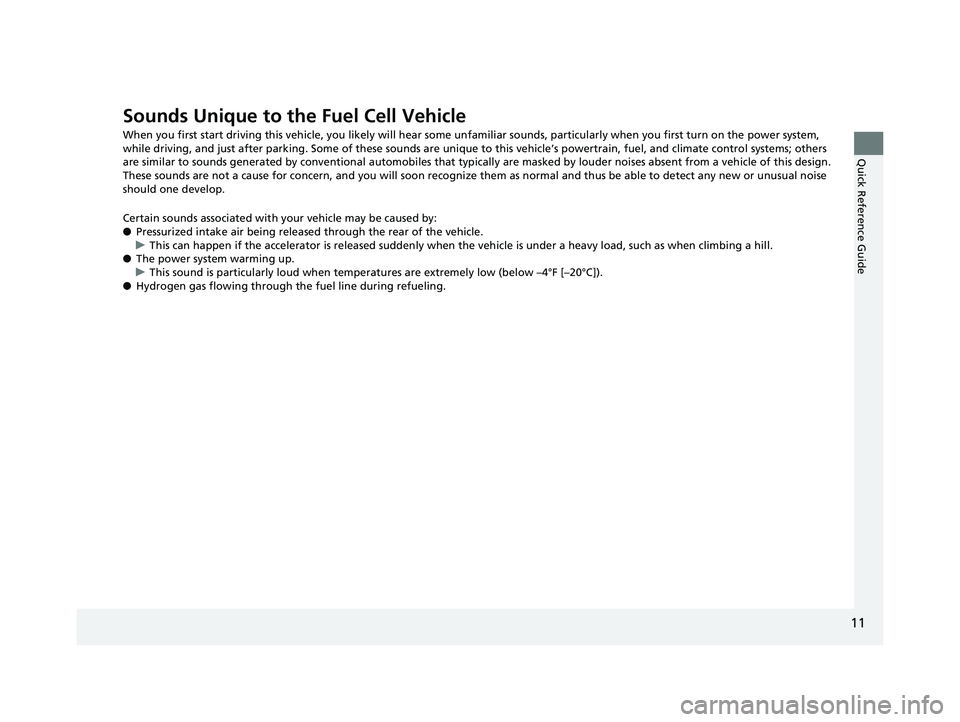
11
Quick Reference Guide
Sounds Unique to the Fuel Cell Vehicle
When you first start driving this vehicle, you likely will hear some unfamiliar sounds, particularly when you first turn on the power system,
while driving, and just after parking. Some of these sounds are unique to this vehicle’s powertrain, fuel, and climate control systems; others
are similar to sounds generated by conventional automobiles that typically are masked by louder noises absent from a vehicle of this design.
These sounds are not a cause for concern, and you will soon recognize them as normal and thus be able to detect any new or unus ual noise
should one develop.
Certain sounds associated with your vehicle may be caused by:
● Pressurized intake air being released through the rear of the vehicle.
u This can happen if the accelerator is released suddenly when the vehicle is under a heavy load, such as when climbing a hill.
● The power system warming up.
u This sound is particularly loud when temperat ures are extremely low (below –4°F [–20°C]).
● Hydrogen gas flowing through the fuel line during refueling.
17 CLARITY FCV PPO-31TRT6000.book 11 ページ 2016年10月27日 木曜日 午後3時 11分
Page 14 of 527
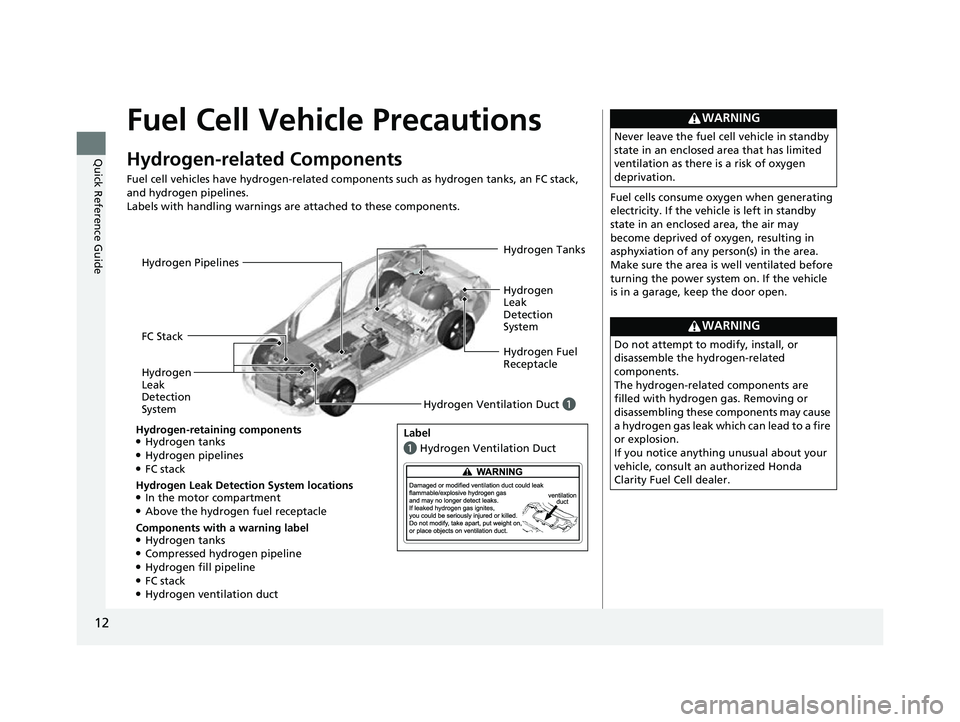
12
Quick Reference Guide
Fuel Cell Vehicle Precautions
Hydrogen-related Components
Fuel cell vehicles have hydrogen-related components such as hydrogen tanks, an FC stack,
and hydrogen pipelines.
Labels with handling warnings are attached to these components.
Hydrogen
Leak
Detection
System
FC StackHydrogen
Leak
Detection
System
Hydrogen Fuel
Receptacle Hydrogen Tanks
Hydrogen Pipelines
Hydrogen-retaining components
●Hydrogen tanks●Hydrogen pipelines●FC stack
Components with a warning label
●Hydrogen tanks●Compressed hydrogen pipeline●Hydrogen fill pipeline●FC stack●Hydrogen ventilation duct
Hydrogen Leak Detection System locations
●In the motor
compartment●Above the hydrogen fuel receptacle Hydrogen Ventilation Duct
a
Label
a Hydrogen Ventilation Duct
Fuel cells consume oxygen when generating
electricity. If the vehicle is left in standby
state in an enclosed area, the air may
become deprived of oxygen, resulting in
asphyxiation of any person(s) in the area.
Make sure the area is well ventilated before
turning the power system on. If the vehicle
is in a garage, keep the door open.
WARNING
Never leave the fuel cell vehicle in standby
state in an enclosed area that has limited
ventilation as there is a risk of oxygen
deprivation.
WARNING
Do not attempt to modify, install, or
disassemble the hydrogen-related
components.
The hydrogen-related components are
filled with hydrogen gas. Removing or
disassembling these components may cause
a hydrogen gas leak which can lead to a fire
or explosion.
If you notice anything unusual about your
vehicle, consult an authorized Honda
Clarity Fuel Cell dealer.
17 CLARITY FCV PPO-31TRT6000.book 12 ページ 2016年10月27日 木曜日 午後3時 11分
Page 15 of 527
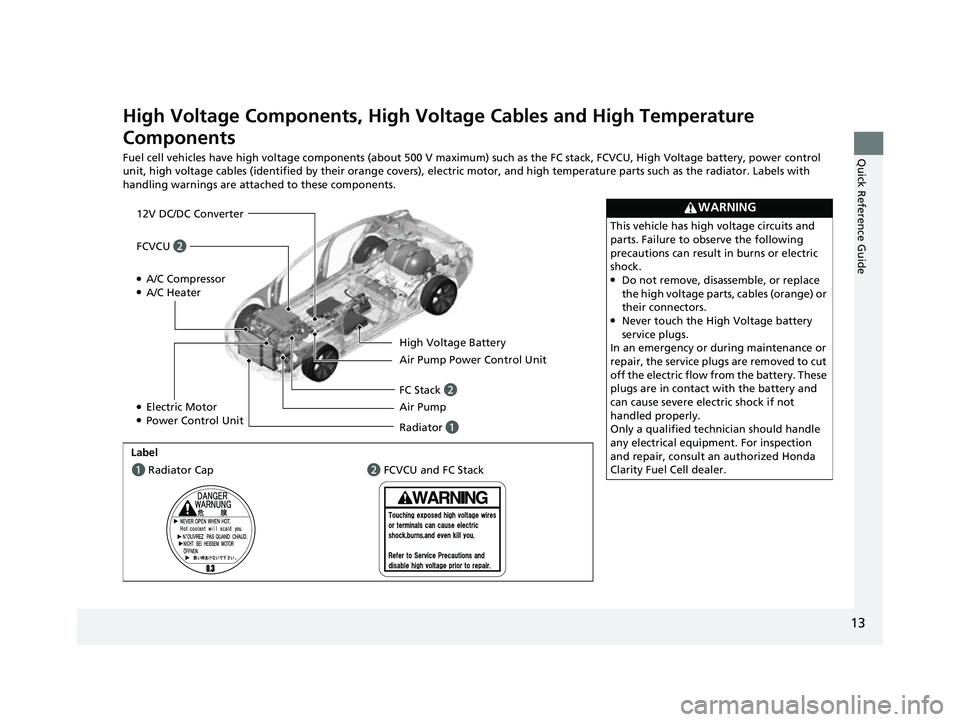
13
Quick Reference Guide
High Voltage Components, High Voltage Cables and High Temperature
Components
Fuel cell vehicles have high voltage components (about 500 V maximum) such as the FC stack, FCVCU, High Voltage battery, power control
unit, high voltage cables (identified by their orange covers), el ectric motor, and high temperature parts such as the radiator. Labels with
handling warnings are attached to these components.
WARNING
This vehicle has high voltage circuits and
parts. Failure to observe the following
precautions can result in burns or electric
shock.
●Do not remove, disassemble, or replace
the high voltage parts, cables (orange) or
their connectors.
●Never touch the High Voltage battery
service plugs.
In an emergency or during maintenance or
repair, the service plugs are removed to cut
off the electric flow from the battery. These
plugs are in contact with the battery and
can cause severe electric shock if not
handled properly.
Only a qualified technician should handle
any electrical equipment. For inspection
and repair, consult an authorized Honda
Clarity Fuel Cell dealer.
12V DC/DC Converter
●A/C Compressor●A/C Heater
Radiator a Air Pump FC Stack b Air Pump Power Control Unit High Voltage Battery
●Electric Motor●Power Control Unit
Labela Radiator Cap b FCVCU and FC Stack
FCVCU b
17 CLARITY FCV PPO-31TRT6000.book 13 ページ 2016年10月27日 木曜日 午後3時 11分
Page 16 of 527
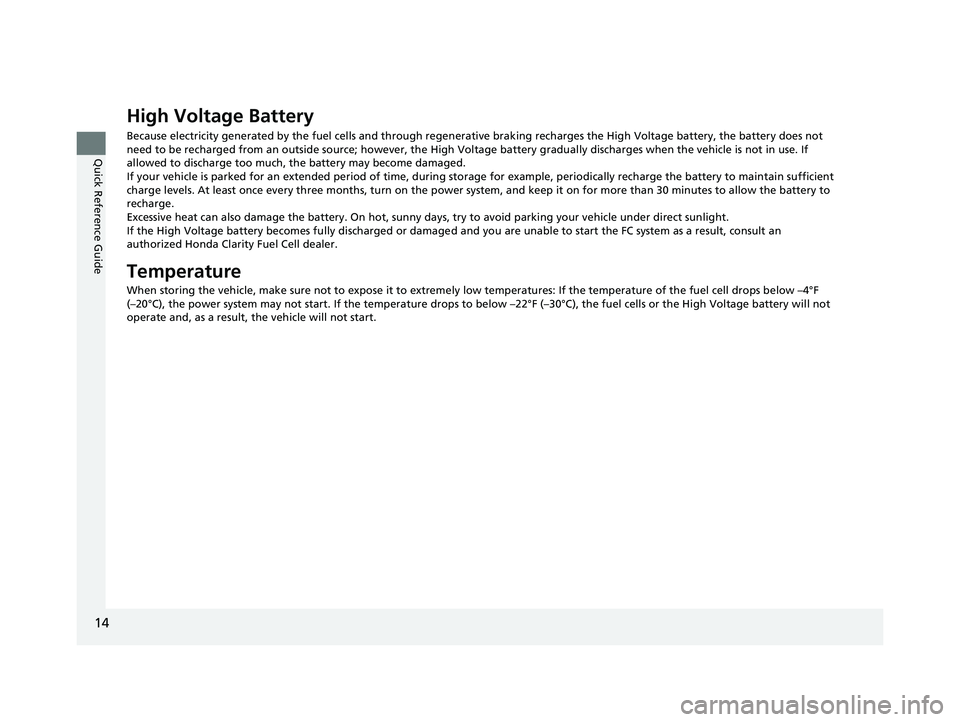
14
Quick Reference Guide
High Voltage Battery
Because electricity generated by the fuel cells and through regenerative braking recharges the High Voltage battery, the batter y does not
need to be recharged from an outside source; however, the High Voltage battery gradually discharges when the vehicle is not in use. If
allowed to discharge too much, the battery may become damaged.
If your vehicle is parked for an extended period of time, du ring storage for example, periodically recharge the battery to main tain sufficient
charge levels. At least once every three months, turn on the power system, and keep it on for more than 30 minutes to allow the battery to
recharge.
Excessive heat can also damage the batter y. On hot, sunny days, try to avoid parking your vehicle under direct sunlight.
If the High Voltage battery becomes fully discharged or damage d and you are unable to start the FC system as a result, consult an
authorized Honda Clarity Fuel Cell dealer.
Temperature
When storing the vehicle, make sure not to expose it to extrem ely low temperatures: If the temperature of the fuel cell drops b elow –4°F
(–20°C), the power system may not start. If the temperature drops to below –22°F (–30°C), the fuel cells or the High Voltage battery will not
operate and, as a result, the vehicle will not start.
17 CLARITY FCV PPO-31TRT6000.book 14 ページ 2016年10月27日 木曜日 午後3時 11分
Page 17 of 527
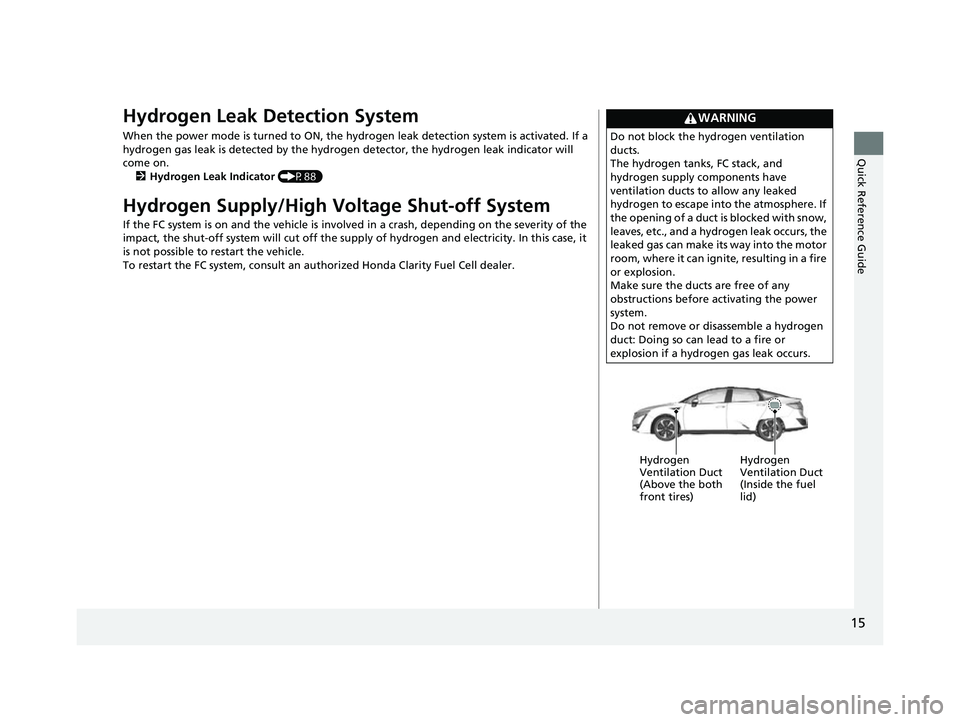
15
Quick Reference Guide
Hydrogen Leak Detection System
When the power mode is turned to ON, the hydrogen leak detection system is activated. If a
hydrogen gas leak is detected by the hydrogen detector, the hydrogen leak indicator will
come on.
2 Hydrogen Leak Indicator (P88)
Hydrogen Supply/High Voltage Shut-off System
If the FC system is on and the vehicle is involv ed in a crash, depending on the severity of the
impact, the shut-off system will cut off the supply of hydrogen and electricity. In this case, it
is not possible to restart the vehicle.
To restart the FC system, consult an authorized Honda Clarity Fuel Cell dealer.
WARNING
Do not block the hydrogen ventilation
ducts.
The hydrogen tanks, FC stack, and
hydrogen supply components have
ventilation ducts to allow any leaked
hydrogen to escape into the atmosphere. If
the opening of a duct is blocked with snow,
leaves, etc., and a hydrogen leak occurs, the
leaked gas can make its way into the motor
room, where it can ignite, resulting in a fire
or explosion.
Make sure the ducts are free of any
obstructions before activating the power
system.
Do not remove or disassemble a hydrogen
duct: Doing so can lead to a fire or
explosion if a hydrogen gas leak occurs.
Hydrogen
Ventilation Duct
(Above the both
front tires) Hydrogen
Ventilation Duct
(Inside the fuel
lid)
17 CLARITY FCV PPO-31TRT6000.book 15 ページ 2016年10月27日 木曜日 午後3時
11分
Page 18 of 527
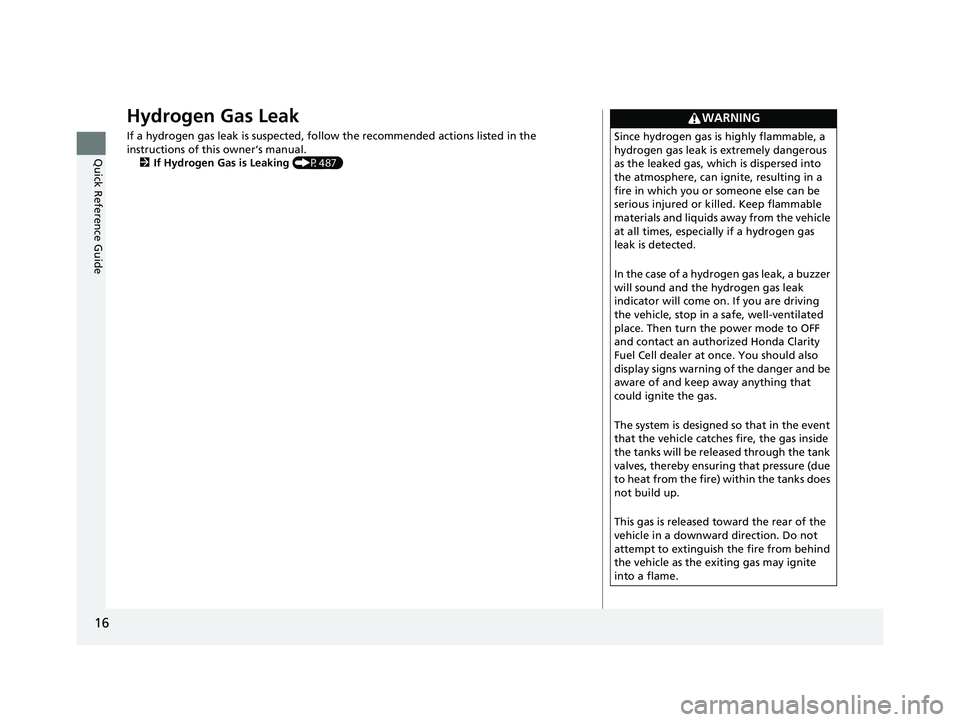
16
Quick Reference Guide
Hydrogen Gas Leak
If a hydrogen gas leak is suspected, follow the recommended actions listed in the
instructions of this owner’s manual. 2 If Hydrogen Gas is Leaking (P487)
WARNING
Since hydrogen gas is highly flammable, a
hydrogen gas leak is extremely dangerous
as the leaked gas, which is dispersed into
the atmosphere, can ignite, resulting in a
fire in which you or someone else can be
serious injured or killed. Keep flammable
materials and liquids away from the vehicle
at all times, especially if a hydrogen gas
leak is detected.
In the case of a hydrogen gas leak, a buzzer
will sound and the hydrogen gas leak
indicator will come on. If you are driving
the vehicle, stop in a safe, well-ventilated
place. Then turn the power mode to OFF
and contact an authorized Honda Clarity
Fuel Cell dealer at once. You should also
display signs warning of the danger and be
aware of and keep away anything that
could ignite the gas.
The system is designed so that in the event
that the vehicle catches fire, the gas inside
the tanks will be released through the tank
valves, thereby ensuring that pressure (due
to heat from the fire) within the tanks does
not build up.
This gas is released toward the rear of the
vehicle in a downward direction. Do not
attempt to extinguish the fire from behind
the vehicle as the exiting gas may ignite
into a flame.
17 CLARITY FCV PPO-31TRT6000.book 16 ページ 2016年10月27日 木曜日 午後3時 11分
Page 19 of 527
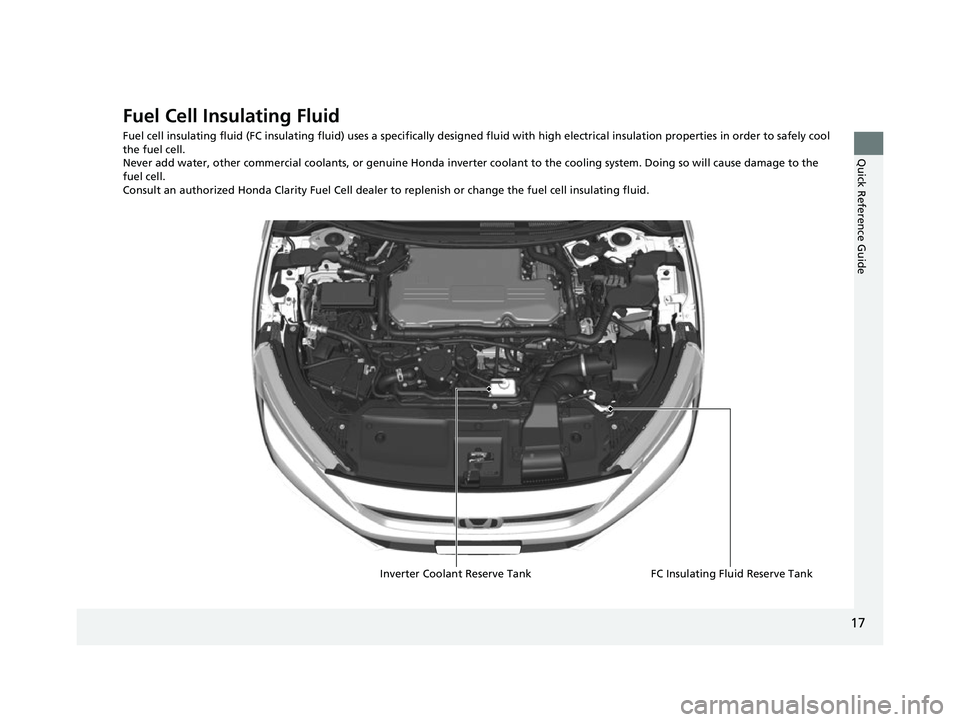
17
Quick Reference Guide
Fuel Cell Insulating Fluid
Fuel cell insulating fluid (FC insulating fluid) uses a specifically designed fluid with high electrical insulation properties in order to safely cool
the fuel cell.
Never add water, other commercial coolants, or genuine Honda inverter coolant to the cooling system. Doing so will cause damage to the
fuel cell.
Consult an authorized Honda Clarity Fuel Cell dealer to replenish or change the fuel cell insulating fluid.
FC Insulating Fluid Reserve Tank
Inverter Coolant Reserve Tank
17 CLARITY FCV PPO-31TRT6000.book 17 ページ 2016年10月27日 木曜日 午後3時 11分
Page 20 of 527
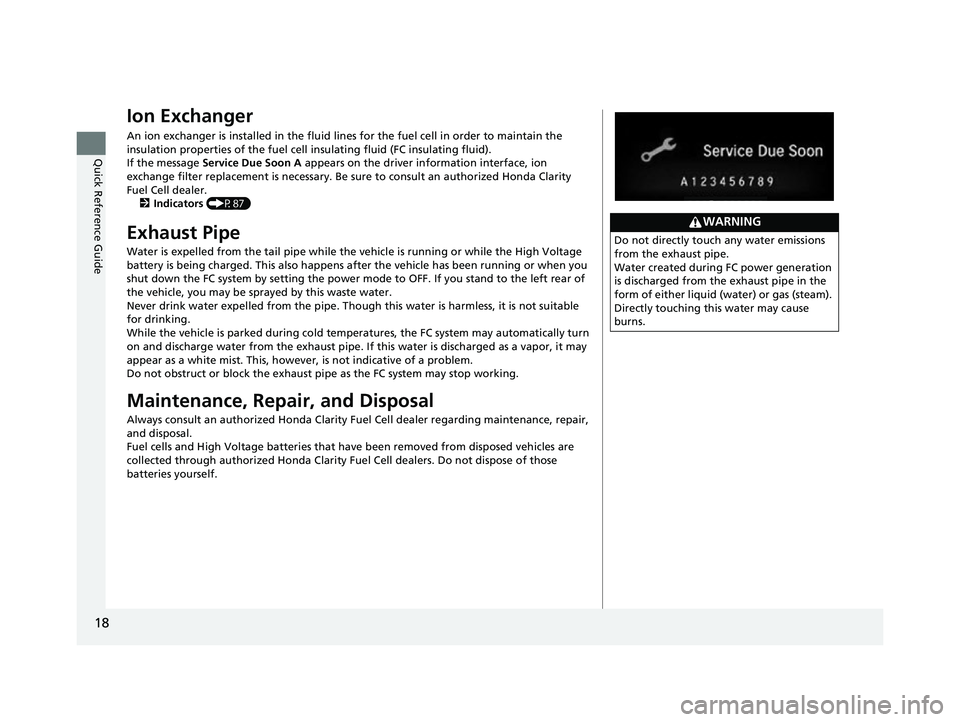
18
Quick Reference Guide
Ion Exchanger
An ion exchanger is installed in the fluid lines for the fuel cell in order to maintain the
insulation properties of the fuel cell insulating fluid (FC insulating fluid).
If the message Service Due Soon A appears on the driver information interface, ion
exchange filter replacement is necessary. Be sure to consult an authorized Honda Clarity
Fuel Cell dealer. 2 Indicators (P87)
Exhaust Pipe
Water is expelled from the tail pipe while the vehicle is running or while the High Voltage
battery is being charged. This also happens af ter the vehicle has been running or when you
shut down the FC system by setting the power mode to OFF. If you stand to the left rear of
the vehicle, you may be sprayed by this waste water.
Never drink water expelled from the pipe. Though this water is harmless, it is not suitable
for drinking.
While the vehicle is parked during cold temperatures, the FC system may automatically turn
on and discharge water from the ex haust pipe. If this water is discharged as a vapor, it may
appear as a white mist. This, however, is not indicative of a problem.
Do not obstruct or block the exhaust pi pe as the FC system may stop working.
Maintenance, Repair, and Disposal
Always consult an authorized Honda Clarity Fuel Cell dealer regarding maintenance, repair,
and disposal.
Fuel cells and High Voltage batteries that have been removed from disposed vehicles are
collected through authorized Honda Clarity Fuel Cell dealers. Do not dispose of those
batteries yourself.
WARNING
Do not directly touch any water emissions
from the exhaust pipe.
Water created during FC power generation
is discharged from the exhaust pipe in the
form of either liquid (water) or gas (steam).
Directly touching this water may cause
burns.
17 CLARITY FCV PPO-31TRT6000.book 18 ページ 2016年10月27日 木曜日 午後3時 11分